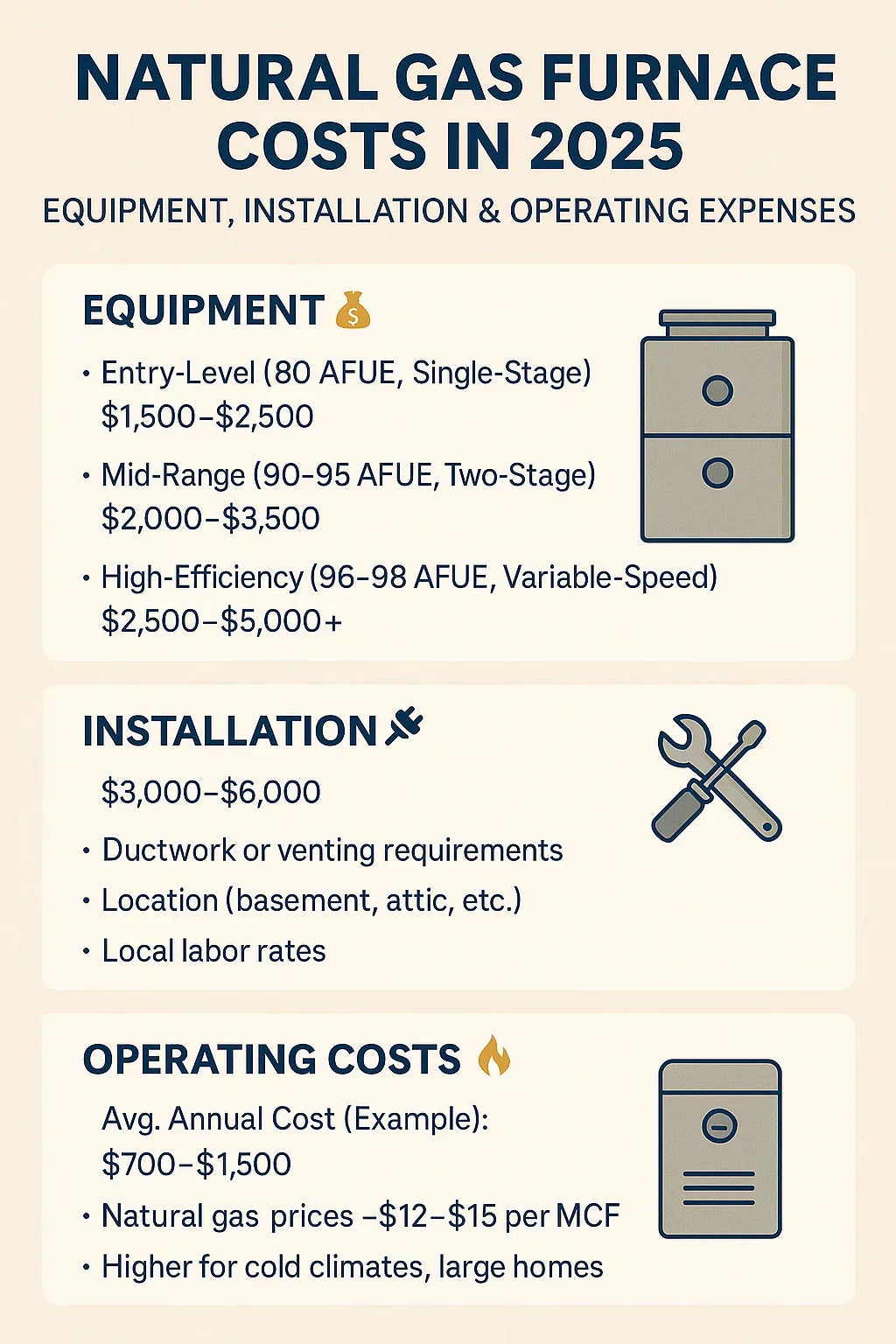👋 Introduction: The Real Cost of Staying Warm in 2025
Thinking about replacing or upgrading your furnace in 2025? You’re not alone. With colder winters in much of the U.S. and natural gas prices shifting year to year, more homeowners are asking:
👉 How much does a natural gas furnace really cost in 2025?
The answer isn’t just a single number—it’s a combination of equipment costs, installation charges, and ongoing operating expenses. And depending on where you live, what size furnace you need, and whether you go for standard or high efficiency, your total cost of ownership could vary by thousands of dollars.
Don’t worry—I’ll break it down Savvy-style: clear, practical, and budget-conscious.
💰 1. Equipment Costs for Natural Gas Furnaces in 2025
The equipment cost is what you pay for the furnace itself—before labor, installation, or modifications.
Price Ranges (By Efficiency Tier)
-
Entry-Level (80 AFUE, Single-Stage): $1,500–$2,500
-
Lowest upfront cost, but least efficient.
-
-
Mid-Range (90–95 AFUE, Two-Stage): $2,000–$3,500
-
Better balance of price and efficiency.
-
-
High-Efficiency (96–98 AFUE, Variable-Speed): $2,500–$5,000+
-
Higher upfront, but lower long-term operating costs.
-
Example: Goodman 96 AFUE 80,000 BTU
The Goodman GRVT960803BN (96 AFUE, two-stage, variable-speed) usually falls around $2,200–$2,800 equipment-only.
👉 Compared to Carrier or Trane equivalents, Goodman tends to be 20–30% more affordable while offering the same efficiency rating.
🛠️ 2. Installation Costs in 2025
Buying the furnace is only half the story. Installation adds a big chunk to the overall cost.
Typical Installation Costs
-
National average: $3,000–$6,000 (HomeAdvisor).
What Affects Installation Price?
-
Labor Rates: Higher in urban areas, lower in rural regions.
-
Ductwork Modifications: Adding or sealing ducts can add $1,000–$3,000.
-
Location of Install:
-
Basement (easier, cheaper).
-
Crawlspace or attic (harder, pricier).
-
-
Venting Requirements:
-
High-efficiency furnaces need PVC venting and condensate drainage.
-
Older homes may need updates to meet code.
-
-
Permits and Inspections: Local code requirements add fees.
👉 Savvy’s Tip: Always get 3 written quotes—prices for the same install can vary by thousands.
📊 3. Total Installed Cost Estimates (By Tier)
Here’s what you can expect to pay in 2025 for a full system replacement:
| Furnace Tier | Equipment | Install | Total Estimated Cost |
|---|---|---|---|
| Budget (80 AFUE) | $1,500–$2,500 | $3,000–$4,000 | $5,000–$6,500 |
| Mid-Range (90–95 AFUE) | $2,000–$3,500 | $3,000–$5,000 | $6,500–$8,500 |
| High-Efficiency (96–98 AFUE) | $2,500–$5,000 | $3,500–$7,000 | $8,000–$12,000 |
👉 Notice how Goodman’s 96 AFUE 80k BTU furnace lands in the mid-upper tier but costs thousands less than Carrier or Trane’s equivalent models.
🔥 4. Operating Expenses: Natural Gas Bills in 2025
Your furnace cost doesn’t end at installation—it’s also about monthly gas bills.
Natural Gas Prices (2025 Estimates)
-
Average U.S. natural gas price: $12–$15 per thousand cubic feet (MCF) (EIA.gov).
Annual Heating Costs (By Furnace Efficiency)
-
80 AFUE: Wastes 20% of fuel → higher bills.
-
96 AFUE: Only 4% wasted → ~20% lower annual bills.
For a typical 2,000 sq ft home in a cold climate:
-
80 AFUE furnace = $1,200/year in gas.
-
96 AFUE furnace = ~$950/year in gas.
👉 Over 15 years, that’s $3,750+ in savings with a high-efficiency model.
🌍 5. Regional Differences in Furnace Costs & Bills
Cold Climates (Midwest, Northeast)
-
Larger furnaces (80,000–100,000 BTUs).
-
Higher install costs ($6,000–$9,000).
-
Higher annual bills ($1,200–$1,800).
Warm Climates (South, Southwest)
-
Smaller furnaces (40,000–60,000 BTUs).
-
Lower install costs ($3,500–$6,000).
-
Lower annual bills ($500–$800).
West Coast
-
Stricter energy codes → most homes require 90+ AFUE.
-
Rebates are higher here (California, Oregon, Washington).
📉 6. Rebates, Tax Credits, and Incentives in 2025
One of the smartest ways to offset furnace costs is to grab rebates and credits.
Federal
-
25C Tax Credit: Up to $600 for qualifying high-efficiency gas furnaces (ENERGY STAR).
State/Utility Rebates
-
$200–$1,200 possible depending on location.
-
Example: Midwest utilities often give $500+ for 96 AFUE models.
Why It Matters
A $2,800 Goodman furnace might only cost $2,200 net after rebates + credits.
🔧 7. Maintenance & Repair Costs to Expect
Even the best furnace needs upkeep.
Annual Maintenance
-
Professional tune-up: $100–$200/year.
-
Includes filter checks, safety inspection, and cleaning.
Common Repairs
-
Ignitor: $150–$300.
-
Flame sensor: $200–$400.
-
Blower motor: $400–$800.
-
Heat exchanger (if not under warranty): $1,000–$2,000.
👉 Goodman’s lifetime heat exchanger warranty covers this expensive part, giving it an advantage over Carrier and Trane.
💡 8. Cost-Saving Tips from Savvy
Here’s how homeowners can stretch every dollar:
-
Don’t oversize your furnace. Match BTUs to your home (get a Manual J load calc).
-
Seal your ductwork. Leaky ducts waste up to 30% of heated air
-
Use a programmable or smart thermostat. Cuts energy use by 10–15%.
-
Shop equipment separately. Buy from online retailers (like The Furnace Outlet) and hire your own installer.
-
Get multiple quotes. Installation markups vary wildly between contractors.
✅ Conclusion: Budgeting Smart for 2025 Furnace Costs
Let’s recap the real costs of a natural gas furnace in 2025:
-
Equipment: $2k–$5k (Goodman ~$2,200–$2,800).
-
Installation: $3k–$6k.
-
Operation: $700–$1,500/year in gas.
-
Maintenance: $100–$200/year.
Over a furnace’s 15–20 year lifespan, the “cheaper” option isn’t always cheaper. A 96 AFUE Goodman furnace can save thousands in operating costs compared to an 80 AFUE, all while costing less upfront than premium competitors.
👉 Check out the Goodman 96 AFUE 80,000 BTU Furnace at The Furnace Outlet here.
It’s affordable, efficient, and flexible—the smart pick for 2025 homeowners.
In the next topic we will know more about: How Quiet Is a Variable Speed Furnace? Noise Levels Compared







